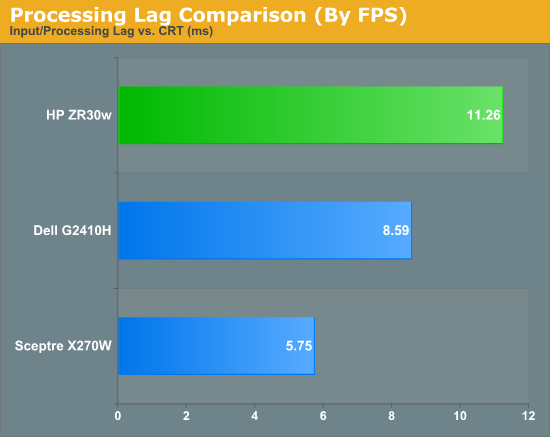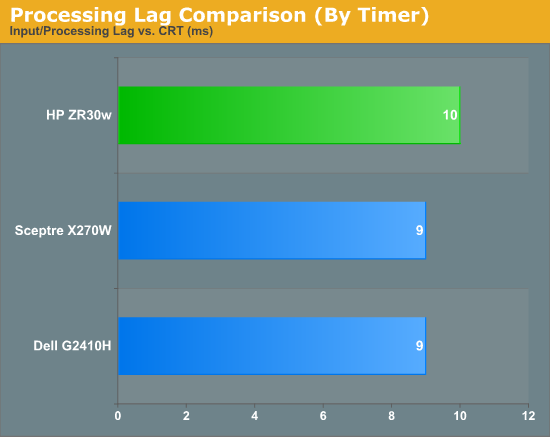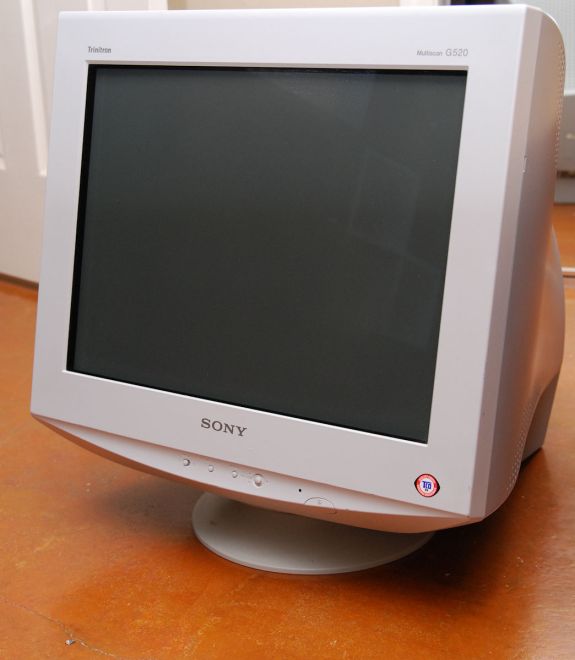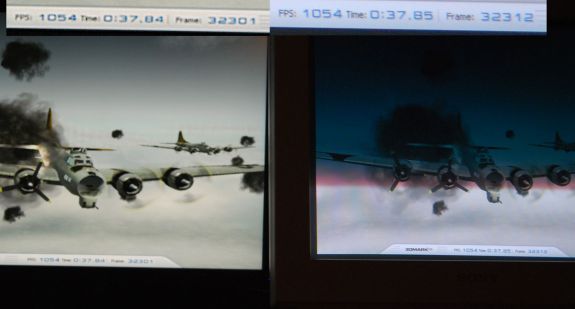A New 30" Contender: HP ZR30w Review
by Brian Klug on June 1, 2010 6:30 PM EST
Display Lag and Response Time
For gamers, display lag is a very real concern, and display processing is a nebulously reported (if at all) specification for just about all LCD displays. We’ve been over this before, but ultimately, what matters isn’t GTG, full on, full off pixel response times, or what’s reported on the spec sheet, but the holistic latency of the monitor compared to something we can all agree is lag-free. We previously used a baseline LCD and compared with it as our benchmark of no display lag. Previously we were using a 17” Princeton CRT - some of you were a bit underwhelmed by that monitor.
I spent some time visiting (I kid you not) almost every thrift store in town, and found myself a veritable cornucopia of uh... lovingly cared for CRTs to choose from. I settled on a much more modern looking Sony G520 20” CRT supporting a higher resolution and refresh rate. It’s still not what I’m ultimately looking for, but it’s better. Oh, and it cost a whopping $9. ;)
As I mentioned earlier, the only downside is that this means our old data is no longer a valid reference.
To compute the processing lag, I do two things. First, I watch for differences in the clock between the CRT and LCD, noting these whenever they are visible. I did this for 10 captures of the same sequence. Second, one can compute the processing difference by taking into account the FPS and the frame number difference.


We’re still evolving what we think the best way to measure processing lag is, and even using a CRT isn’t foolproof. In this case, I set the LCD and CRT refresh rates to 60 Hz so both in theory grab the same frame from the GPU’s framebuffer. In practice, it’s likely that they just aren’t, explaining the difference. As we process more LCDs, we’ll be able to tell, but the processing lag we’ve measured from all three monitors this far is totally acceptable.
I played a number of FPS titles and RTS games on the display, and never noticed any display processing lag or ghosting to speak of. If you’re going to use a 30” panel for gaming, the ZR30w seems to be just as good as any.
In the ghosting images I snapped, I usually only saw two frames. The dominant frame, and the preceding frame. This is very surprising, since we’re used to seeing three. But all throughout the images I snapped, only two frames are visible. This is very impressive panel response.













95 Comments
View All Comments
IceDread - Tuesday, September 21, 2010 - link
Good review, very good to keep at it with input lag, very important for me.This monitor would be the perfect one if it just would be 120Hz!
I so would love an ips panel at 30" with 120Hz!!
FXi - Friday, September 24, 2010 - link
Even if it had an HDMI connector it wouldn't go higher than 1920x1080. Check out other high res HP monitors that have HDMI. Dell is the same way. Despite HDMI "being able" to output higher resolutions, ALL PC monitor HDMI inputs only recognize as high as 1920x1200 and most only do 1920x1080. So don't wish for an HDMI port. It won't do you much good.FXi - Friday, September 24, 2010 - link
Since many folks debate the U2711 and the ZR30 and the U3008/3011, it would be interesting to see how things fall.As always, very disappointed the IPS hasn't YET managed after decades, to cure it's low contrast issues. Any TV owner will tell you that contrast and black level really make a display look fantastic and PC monitors are no different.
James5mith - Thursday, November 18, 2010 - link
Just wondering if anyone else has been able to get this monitor working on a Mac Pro with Dual-Link DVI.It would seem that DisplayPort bypasses the issue, but Dual-Link DVI fails to display. The monitor shows that it is getting a signal, the backlight is active, but the screen is blank. The Mac Pro thinks that the monitor is active, and has extended the display to it, but you cannot see anything.
Odd, issue, and I've confirmed that the display and cable work on other systems. It is just the Mac Pro that is having the issue. Wanted to use this as a replacement for a 30" ACD, but it looks like I'll be returning it instead.
Matrices - Friday, November 19, 2010 - link
It is so strange that you should mention this. I just received my monitor today and it has this exact same problem - except that it's defective across the board (on Windows 7 and Vista systems). Same symptoms, though: lights up, recognized by Windows, but displays absolutely nothing using the DVI. Nvidia cards don't have DP so I can't figure out if it's just the port that's defective or what. Anyway, I'm returning it, obviously.momofone - Friday, January 7, 2011 - link
I have a Dell workstation with nVidia Quadro FX 4500 with dvi-d connectors and I have exactly the same issue - blank screen. Acts like something should be displayed, i.e. the backlight is active, but nothing, nada, totally blank.Shame. Looks like this monitor is incompatible with the FX series workstation cards. I can connect the Apple 30" ACD and it work fine though. Looks like I will have to think about another ACD.
eajohnson - Tuesday, December 7, 2010 - link
I just bought a ZR30W last week and while it is performing well with no functional problems that I can see, the construction seems a little odd in that the panel is loose at the top (if I push very gently anywhere along the top of the panel, it can be pushed inward but stops after a few mm i.e. is not secured. Is this normal? Anyone know why it would be part of the design for it to be loose like that? At any of the other edges the panel appears to not be loose.I tried HP forums and calling HP tech support but they didn't seem to know, what I need is to find other owners that can try theirs and let me know if mine is normal or is defective.
SanFranShootr - Monday, January 3, 2011 - link
I've read on some other sites that Mac owners who have the ZR30W are having screen flicker problems when they updated from 10.6.4 to 10.6.5.Does anyone know whether this 10.6.5 problem has been resolved?
Rohirm - Saturday, January 8, 2011 - link
I have ZR30W connected via DP to Mac Pro Mid 2010 (HD5870). No problems here. Using OS X version 10.6.6NetJunky - Sunday, February 6, 2011 - link
I'm new on this website, but I have a question too. Will there be review of cheeper displays? Which one is better and why. Since I think, that not everyone can afford ZR30w.By the way, review was great. Very initeresting.